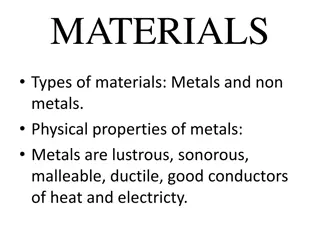Exploring the Conductivity of Metals in Electrical Circuits
This science fair project investigates how different metals affect the amount of current in an electrical circuit. It explores why metals are used to conduct electricity, which metal is the best conductor, and includes a hypothesis based on research findings. The experimental design involves setting up a circuit with pieces of silver, copper, zinc, and aluminum to measure current using a multimeter. The project aims to determine the impact of metal type on current flow in circuits.
Download Presentation

Please find below an Image/Link to download the presentation.
The content on the website is provided AS IS for your information and personal use only. It may not be sold, licensed, or shared on other websites without obtaining consent from the author. Download presentation by click this link. If you encounter any issues during the download, it is possible that the publisher has removed the file from their server.
E N D
Presentation Transcript
Science Fair: November 29, 2018 Will include dinner similar format to last year Students can present in class or at science fair Tri-fold boards are provided by school 1
How does the type of metal affect how much current a circuit has? 2
Electrical Circuits Electrical circuits work because the electrons are able to flow from the positive side of the battery to the negative side. http://sub.allaboutcircuits.com/images/00438.png http://hdz.horizonpower.com.au/assets/section/circuit.gif 3
Why are metals used to conduct electricity? http://www.slideshare.net/HenryEmuna/conduction-lesson-2 http://chemistry-igcse1.weebly.com/supplement9.html 4
Which metal is the best conductor? Pure silver is the best conductor of electricity, then copper, and then aluminum. Silver is the best conductor because it has the least resistance to the flow of electricity. According to Ohm's Law, current is equal to voltage divided by resistance. https://learn.sparkfun.com/tutorials/voltage-current-resistance-and-ohms-law 5
Research Sources Sources of information on electrical resistance of metals: 1. "How Voltage, Current, and Resistance Relate." All About Circuits Forum RSS. N.p., n.d. Web. 01 Oct. 2013. 2. "Resistivities for Common Metals." Resistivities for Common Metals. N.p., n.d. Web. 01 Oct. 2013. 3. "TIBTECH Innovations." Conductive Materials or Metal Conductivity. N.p., n.d. Web. 01 Oct. 2013. 4. "How to Use a Multimeter." - Learn.SFE. N.p., n.d. Web. 01 Oct. 2013
Hypothesis Based on my research, I predict that the current flow will be greatest with the silver wire. I think this because the chart on page 4 shows that silver has the highest conductivity. 7
Experimental Design piece of wire For my experiment, I put together the circuit shown to the right. Between two of the clip wires, I inserted pieces of different types of metal (silver, copper, zinc, and aluminum). I used a multimeter to measure the amount of current in amps in the completed circuit. The information on page 7 shows how to set up a multimeter to measure current. To get multiple trials, I moved the piece of metal to three different places in the circuit and measured the amps produced in each of the three circuits. 8
Page for explaining/ displaying: How a specific piece of equipment works that is used in experiment Recipe for items baked for experiment. Survey questions if a survey was used in the experiment Rating scale if a rating scale was used in the experiment How is the amount of current in a circuit measured? An ammeter is used to measure the amount of current in a circuit. The positive and negative probes from the ammeter are connected up to the circuit. 9 http://sub.allaboutcircuits.com/images/05057.png
Results Type of Metal vs. Current Produced Type of Metal Current (amps) Trial 1 Trial 2 Trial 3 Average Zinc 0.05 0.07 0.06 0.06 Aluminum 0.12 0.14 0.11 0.12 Silver 0.22 0.25 0.23 0.24 Copper 0.19 0.17 0.18 0.18 8
Average current produced vs. type of metal 0.3 0.25 0.2 Average current produced (amps) 0.15 Average Current 0.1 0.05 0 zinc aluminum Type of Metal silver copper 11
Discussion of results Based on my data, I can conclude that the type of metal that produced the greatest current was silver, and the type of metal that produced the lowest current was zinc. The average amperage reading for silver was 0.24 amps and the average for zinc was 0.06 amps. The averages for copper and aluminum fell in the middle range with an average of 0.12 amps for aluminum and 0.18 amps for copper. results are also in agreement with the research I read on resistance. That information said that zinc would have the greatest resistance, which would result in the lowest current flow. I was surprised to see that aluminum was the next lowest reading. I had thought that it would have a higher reading than the copper. The results of my experiment support my hypothesis. The 12
Discussion of possible sources of error In conducting my research, I realized there were some aspects of my set-up that may have had an effect on the results. The pieces of metal I used were not all the same length and I know that the length of the metal affects its resistance. Another possible source of error was the voltage of the battery. I checked it frequently throughout the experiment, but it may have varied a little bit from trial to trial which may have affected the results. sure to use metal pieces that were all the same size and to have a large enough supply of batteries so that the same battery was not used twice. If I were to conduct the experiment again, I would make 13
Application and implications for future research The results of my research would be helpful to people who are doing electrical work. My research shows that silver and copper are best two metals to use. I would guess that copper is used more than silver because of its lower cost. came to mind that I might want to research in the future. I would be interested to see if or how much the length of the metal affects current flow. I could have several pieces of the same metal that were different sizes. I would also be interested to find out how other metals, such as gold and tin, compare to the metals I studied in the experiment. After conducting the experiment, some other questions 14
Results Dependent Variable vs. Independent Variable Independent Variable Dependent Variable Trial 1 Subject 1 Trial 2 Subject 2 Trial 3 Subject 3 Average Subject 4 Subject 5 Take a picture!






















